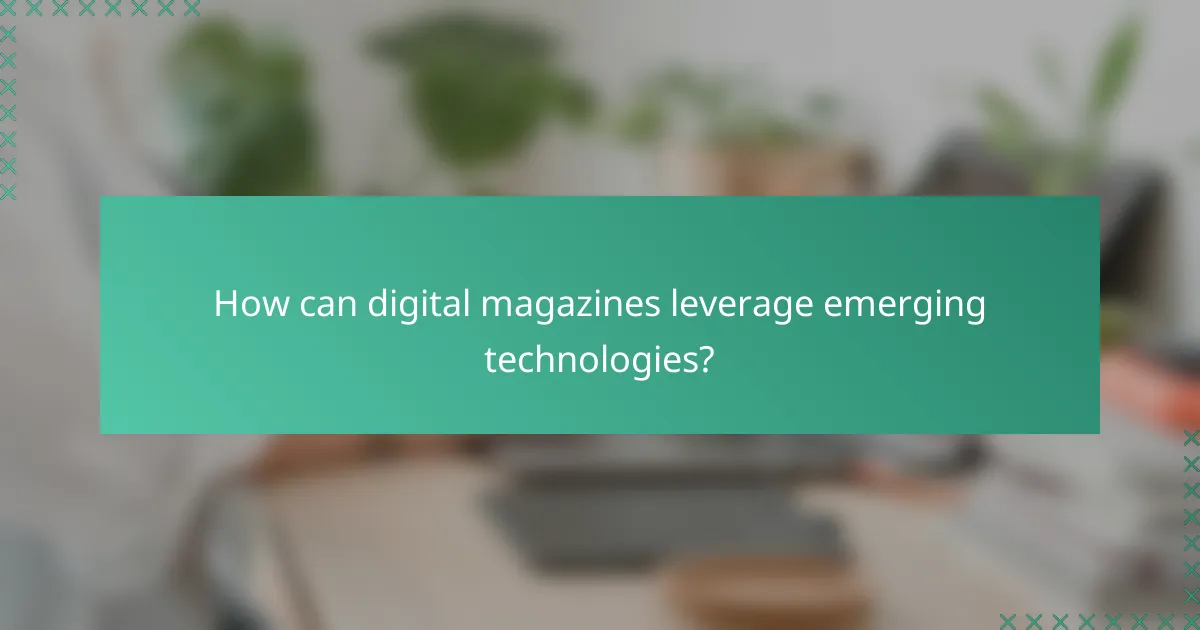Digital magazines require careful content planning, effective design software, and strategic distribution methods to succeed. Understanding your audience and utilizing tools like Adobe InDesign or Canva can enhance the creation process, while employing a mix of email marketing and social media ensures your publication reaches a wider audience. By focusing on these key areas, you can create engaging and impactful digital magazines that resonate with readers.

What are effective content planning strategies for digital magazines in Australia?
Effective content planning strategies for digital magazines in Australia involve understanding the target audience, creating a structured content calendar, and utilizing collaborative tools. These strategies help ensure that the content is relevant, timely, and engaging for readers.
Audience analysis techniques
Audience analysis techniques are essential for tailoring content to meet the interests and needs of readers. This can include surveys, social media insights, and analytics tools to gather demographic information and preferences. Understanding your audience helps in creating content that resonates and drives engagement.
Consider segmenting your audience based on factors like age, interests, and reading habits. This segmentation allows for more personalized content, which can enhance reader loyalty and increase subscription rates.
Content calendar development
Developing a content calendar is crucial for maintaining a consistent publishing schedule. A well-structured calendar outlines topics, deadlines, and responsible team members, ensuring that everyone is aligned and accountable. This can be created using tools like Google Calendar or Trello.
When planning your calendar, consider seasonal events, holidays, and industry trends that may influence content relevance. Aim for a mix of evergreen and timely content to keep your magazine fresh and engaging throughout the year.
Collaborative brainstorming tools
Collaborative brainstorming tools facilitate idea generation among team members, leading to more diverse and innovative content. Platforms like Miro, Slack, or Microsoft Teams allow for real-time collaboration, making it easier to share ideas and feedback.
Encourage regular brainstorming sessions to foster creativity. Use techniques such as mind mapping or SWOT analysis to explore different angles for your content, ensuring that all voices are heard and considered.
SEO keyword integration
Integrating SEO keywords into your content planning is vital for improving visibility in search engines. Research relevant keywords using tools like Google Keyword Planner or SEMrush, focusing on terms that your target audience is likely to search for.
Incorporate these keywords naturally into your articles, headings, and meta descriptions without compromising readability. Aim for a keyword density of around 1-2% to optimize your content while maintaining a smooth flow.
Performance metrics tracking
Tracking performance metrics is essential for evaluating the effectiveness of your content strategy. Use analytics tools like Google Analytics to monitor key indicators such as page views, bounce rates, and reader engagement over time.
Regularly review these metrics to identify trends and areas for improvement. Set specific goals, such as increasing subscriber numbers or enhancing reader retention, and adjust your content strategy accordingly to meet these objectives.

Which design software is best for creating digital magazines?
The best design software for creating digital magazines depends on your skill level and specific needs. Popular choices include Adobe InDesign for professionals, Canva for beginners, Affinity Publisher for cost-effective solutions, and Lucidpress for collaborative projects.
Adobe InDesign features
Adobe InDesign is a leading choice for professional digital magazine design, offering advanced layout tools, typography options, and integration with other Adobe products. It supports interactive elements like hyperlinks and videos, making it ideal for engaging digital content.
Key features include master pages for consistent layouts, extensive font libraries, and precise control over text and image placement. However, it requires a subscription, which can be a consideration for budget-conscious users.
Canva for beginners
Canva is an excellent option for those new to digital magazine design, providing an intuitive drag-and-drop interface. It offers a wide range of templates and design elements, allowing users to create visually appealing magazines without extensive design skills.
While Canva is user-friendly, it may lack some advanced features found in professional software. However, its free version is sufficient for simple projects, and the paid subscription unlocks additional functionalities and assets.
Affinity Publisher advantages
Affinity Publisher is a cost-effective alternative to Adobe InDesign, offering many similar features without a subscription model. Users can create complex layouts with ease, and it supports various file formats, making it versatile for different projects.
Its one-time purchase fee is appealing for freelancers and small businesses. Affinity Publisher also integrates well with other Affinity products, enhancing the overall design workflow.
Lucidpress capabilities
Lucidpress is a cloud-based design tool that excels in collaboration, making it suitable for teams working on digital magazines. It allows multiple users to edit documents simultaneously, streamlining the design process.
With a library of templates and the ability to embed multimedia, Lucidpress is user-friendly and accessible. However, its features may be limited compared to more robust software like InDesign, so it’s best for simpler projects or teams needing quick turnaround times.

How to distribute digital magazines effectively in Australia?
To distribute digital magazines effectively in Australia, leverage a mix of email marketing, social media, online platforms, and influencer partnerships. Each method has unique advantages that can enhance reach and engagement with your target audience.
Email marketing platforms
Email marketing remains a powerful tool for distributing digital magazines. Platforms like Mailchimp and Campaign Monitor allow you to create targeted campaigns, segment your audience, and track engagement metrics. Aim for a consistent schedule, such as monthly newsletters, to keep your audience informed and engaged.
Consider personalizing your emails with subscriber names and tailored content based on their preferences. This approach can significantly improve open and click-through rates, leading to better readership of your digital magazine.
Social media distribution strategies
Utilizing social media effectively can amplify your digital magazine’s reach. Platforms like Facebook, Instagram, and LinkedIn are ideal for sharing snippets, visuals, and links to your magazine. Create engaging posts that encourage shares and interactions, such as polls or questions related to your content.
Utilize targeted ads to reach specific demographics in Australia, ensuring your magazine reaches potential readers who are likely to be interested in your content. Regularly analyze engagement metrics to refine your strategy and improve future posts.
Online magazine platforms
Publishing your digital magazine on online platforms like Issuu or Joomag can enhance visibility and accessibility. These platforms allow for easy sharing and embedding on websites, increasing the likelihood of reaching a broader audience. Ensure your magazine is optimized for mobile viewing, as many users will access it on their devices.
Consider offering a free issue or a preview to attract new readers. This tactic can entice potential subscribers to explore your content further and convert them into loyal readers.
Partnerships with influencers
Collaborating with influencers can significantly boost your digital magazine’s distribution. Identify influencers in your niche who have a strong following in Australia and align with your magazine’s themes. They can help promote your content through their channels, reaching audiences you may not have accessed otherwise.
When partnering with influencers, provide them with exclusive content or early access to issues. This strategy not only incentivizes them to share your magazine but also adds value for their followers, enhancing your magazine’s appeal.

What are the key criteria for selecting digital magazine software?
When selecting digital magazine software, consider user interface, integration capabilities, and cost versus features. These criteria will help ensure that the software meets your design needs while remaining user-friendly and budget-conscious.
User interface considerations
A user-friendly interface is crucial for both creators and readers of digital magazines. Look for software that offers intuitive navigation, customizable templates, and drag-and-drop functionality. This will streamline the design process and enhance the reader’s experience.
Additionally, consider the accessibility of the interface across devices. Software that is responsive and mobile-friendly can significantly improve engagement, as many readers access content on smartphones and tablets.
Integration with analytics tools
Effective digital magazine software should seamlessly integrate with analytics tools to track reader engagement and behavior. This integration allows you to gather insights on which articles are most popular, how long readers stay on pages, and where they drop off.
Choose software that supports integration with platforms like Google Analytics or other specialized analytics services. This will enable you to make data-driven decisions to enhance content strategy and improve future issues.
Cost vs. features analysis
Evaluating the cost against the features offered is essential for selecting the right digital magazine software. Determine your budget and compare it with the functionalities you need, such as multimedia support, subscription management, and distribution options.
Many software solutions offer tiered pricing models. Consider starting with a basic plan that meets your immediate needs and allows for upgrades as your magazine grows. Be cautious of hidden fees associated with additional features or distribution methods.

How can digital magazines leverage emerging technologies?
Digital magazines can utilize emerging technologies to enhance reader engagement and streamline production processes. By integrating tools like augmented reality, interactive content, and artificial intelligence, publishers can create more immersive and personalized experiences for their audiences.
Augmented reality applications
Augmented reality (AR) can transform static digital magazine content into interactive experiences. By using AR applications, readers can scan images or QR codes to access additional multimedia elements, such as videos or 3D models, enhancing their understanding and enjoyment of the material.
When implementing AR, consider the technical requirements and user accessibility. Ensure that your audience has the necessary devices and apps to engage with AR content. Testing the AR features on various platforms can help identify potential issues before launch.
Interactive content features
Interactive content features, such as quizzes, polls, and clickable infographics, can significantly boost reader engagement in digital magazines. These elements encourage active participation, making the reading experience more dynamic and enjoyable.
To effectively incorporate interactive features, focus on user-friendly design and clear instructions. Avoid overwhelming readers with too many interactive elements at once; instead, integrate them strategically throughout the magazine to maintain interest without distraction.
Artificial intelligence in design
Artificial intelligence (AI) can streamline the design process for digital magazines by automating repetitive tasks and providing design suggestions based on user preferences. AI tools can analyze reader behavior to tailor layouts and content, optimizing the overall user experience.
When using AI in design, balance automation with human creativity. While AI can assist in generating ideas and layouts, ensure that the final product reflects your brand’s unique voice and style. Regularly review AI-generated content to maintain quality and relevance.
